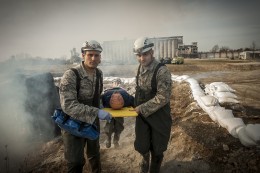The National Center for Medical Readiness (NCMR) at Calamityville this week launched the first in a family of courses designed to prepare medical responders for their “worst day” scenario and opened its first Technical Training Zone focused on complex vehicles, signaling the austere training and research site located at a former cement plant is reaching full operation.
Approximately 20 military and civilian medics participated this week in the Complex Vehicle Course in a family of courses called Sustained Austere Medical Interventions (SAMI), in which medical responders learn to adapt their medical rescue training to the potential challenges and extreme conditions they would encounter during disasters such as the recent Hurricane Sandy.
Medics from local fire departments and the U.S. Air Force School of Aerospace Medicine learned to provide medical treatment in total darkness; waded through waist-high freezing water to reach and treat trapped passengers drowning in a rolled-over armored vehicle; and overcame disorientation to reach patients in a school bus perched precariously on the side of a hill, among other challenges.
While medics are traditionally trained in life-saving techniques, “they aren’t getting this intensity of experience anywhere else in the country,” said James Gruenberg, deputy director of training and a paramedic and medical response veteran. Gruenberg has responded with national rescue efforts for eight hurricanes and who helped FEMA coordinate the rescue efforts at Ground Zero following the World Trade Center attacks on 9/11.
Additional courses are planned in SAMI, which take the fullest advantage of Calamityville’s austere outdoor environment by pushing the professional to their limits. “Students are exposed to what we call ‘their worst day’ in the rescue community,” Gruenberg said. On their worst days, responders find themselves rescuing patients and providing care without their usual equipment, in places difficult to access and extricate patients, and making life-or-death decisions under extreme physical and emotional pressure.
“I’ve never experienced this level of training before,” said Tim Harshman, a paramedic for the Greenville Fire Department. “Learning in this kind of environment is of tremendous benefit for my department.”
University officials also shared plans to develop 45 courses across eight subject areas in varying levels of intensity for the community and medical responders, as well as plans to build eight Technical Training Zones (TTZs) throughout the site to support the planned courses. Planned TTZs include confined spaces, a small airplane crashed into a building, an earthquake village, hazardous materials, and aircraft mishaps.
“As we begin to move to operational status at Calamityville, the university looks forward to delivering the much-anticipated economic impact that will benefit the community,” said Ryan Fendley, interim director of NCMR and director of the Wright State Research Institute, which is managing the site’s growth with the Boonshoft School of Medicine. “NCMR strives to deliver top-tier training, helping Ohio with its preparedness efforts, and continues to serve the defense department in its research into training effectiveness,” he said.
As the number of trainees increases, Calamityville can be used for test and evaluation of new technologies, as well as for research for the U.S. Air Force. Wright State University was recently awarded a $500,000 research contract from the Air Force Research Laboratory’s 711th Human Performance Wing for training and rehearsal for medical and emergency response, disaster preparedness, search and rescue and humanitarian assistance. NCMR and Calamityville are key assets in the successful execution of that contract.
To build its operations, Calamityville has added four, nationally recognized staff members with expertise in test and evaluation and training content, course development in austere medicine, training delivery systems, and working with federal and state agencies.
New courses are planned to launch as early as January.


 Wright State alum Lindsay Aitchison fulfills childhood space-agency dream
Wright State alum Lindsay Aitchison fulfills childhood space-agency dream  Wright State business professor, alumnus honored by regional technology organizations
Wright State business professor, alumnus honored by regional technology organizations  Wright State University Foundation awards 11 Students First Fund projects
Wright State University Foundation awards 11 Students First Fund projects  Gov. DeWine reappoints Board Treasurer Beth Ferris and names student Ella Vaught to Wright State Board of Trustees
Gov. DeWine reappoints Board Treasurer Beth Ferris and names student Ella Vaught to Wright State Board of Trustees  Joe Gruenberg’s 40-Year support for Wright State celebrated with Honorary Alumnus Award
Joe Gruenberg’s 40-Year support for Wright State celebrated with Honorary Alumnus Award 